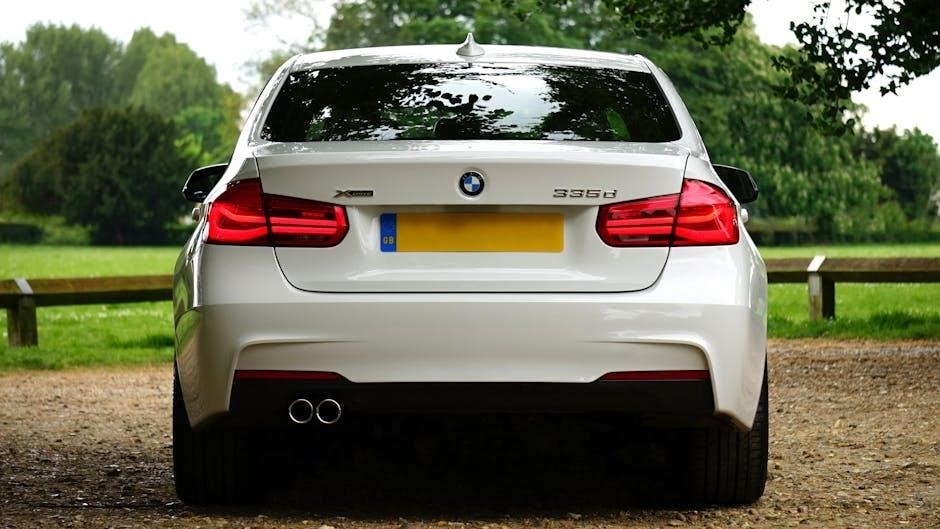Parking a manual car requires skill and attention to detail to ensure safety and control, especially on inclines. Mastering proper techniques prevents accidents and enhances driving confidence.
Importance of Proper Parking Techniques
Proper parking techniques are essential for safety and control, especially with manual cars. Incorrect methods can lead to accidents or vehicle damage. Using the parking brake correctly and selecting the right gear ensures the car remains stationary, even on inclines. Turning wheels toward the curb or edge helps prevent rolling and enhances stability. These practices are vital for securing the vehicle and protecting surrounding objects. Mastering these techniques builds confidence and reduces risks, particularly in challenging scenarios like hills or tight spaces. Proper parking habits also extend the lifespan of your car’s transmission and braking system, making them a cornerstone of responsible driving.
Unique Challenges of Manual Transmission Cars
Manual cars present distinct challenges when parking, primarily due to their reliance on gear selection and clutch control. Unlike automatics, manuals require driver engagement to prevent rolling, especially on hills. The need to use the parking brake firmly and choose the correct gear—first for uphill, reverse for downhill—adds complexity. Improper gear selection can lead to unintended movement, posing safety risks. Additionally, manual transmissions lack the automatic hold feature, making wheel alignment and gear choice critical. These factors demand heightened awareness and precise actions, ensuring the vehicle remains secure in various parking scenarios. Mastering these techniques is crucial for safe and effective parking with a manual car.

Preparation for Parking
Before parking a manual car, check your surroundings, engage the parking brake, and select the appropriate gear. Ensure wheels are turned toward the curb or edge for safety on slopes.
Checking Your Surroundings
Before parking, thoroughly inspect the area for obstacles, pedestrians, and other vehicles. Ensure the space is clear and safe. On hills, check the gradient and potential roll direction. Look for curbs, road signs, and markings to align properly. Use mirrors and glance over your shoulder for better visibility. Assessing the environment helps prevent accidents and ensures the car is secured correctly. Proper observation is crucial, especially in tight spaces or uneven terrain, to avoid damage or hazards. Always prioritize visibility and safety when preparing to park a manual car.
Using the Parking Brake Correctly
Engaging the parking brake is essential for securing a manual car, especially on inclines. Always pull the brake firmly to ensure it locks in place. For uphill parking, set the brake before shifting into first gear, while for downhill, apply it after selecting reverse. This prevents the car from rolling. The parking brake should be your primary means of immobilizing the vehicle, as relying solely on gears is unsafe. Proper use ensures the car remains stationary, even on steep slopes. Always double-check the brake’s engagement for added peace of mind and safety.
Engaging the Correct Gear
Selecting the right gear is crucial when parking a manual car. For uphill parking, shift into first gear to prevent rollback. Downhill, use reverse gear to ensure the car doesn’t roll forward. This gear selection acts as a secondary safety measure alongside the parking brake. Always engage the gear firmly and confirm it’s in place. Proper gear selection ensures the vehicle remains stable and reduces the risk of accidental movement. Remember, relying on the parking brake alone isn’t sufficient, so combining it with the correct gear provides optimal security for your car on any incline.

Parking on a Hill
Parking on a hill requires careful gear selection and wheel alignment. Uphill, use first gear and turn wheels away from the curb. Downhill, use reverse and turn wheels toward the curb. Always engage the parking brake for added safety.
Uphill Parking: Gear Selection and Wheel Alignment
When parking uphill, selecting the correct gear and aligning the wheels properly is crucial. For manual transmission cars, always shift into first gear to prevent the vehicle from rolling. Turn the wheels away from the curb, allowing the car to roll back slightly until the tires gently touch the curb if the brakes fail. This ensures the car doesn’t roll into traffic. Engage the parking brake firmly to add an extra layer of safety. Proper alignment and gear selection help maintain control and prevent accidents. Always double-check your position before exiting the vehicle.
Downhill Parking: Gear Selection and Wheel Alignment
For downhill parking, manual transmission cars should be placed in reverse gear to prevent rolling. Turn the wheels toward the curb or edge to ensure the car doesn’t move into traffic if the brakes fail. Engage the parking brake firmly to add extra security. The correct gear selection acts as a backup, stopping the car from rolling downhill. Aligning the wheels correctly directs the vehicle toward the curb, enhancing safety. Always double-check your position and ensure the car is stable before exiting. Proper downhill parking techniques are essential to avoid accidents and maintain control of the vehicle in sloped environments.
Key Differences Between Uphill and Downhill Parking
The primary distinction lies in gear selection and wheel alignment. Uphill parking requires the car to be in first gear, with wheels turned away from the curb to prevent rolling into traffic. Downhill parking uses reverse gear, with wheels turned toward the curb for added stability. Both scenarios demand proper parking brake use and double-checking the vehicle’s position. Uphill parking directs the car away from traffic if it moves, while downhill parking guides it toward the curb for safety. Understanding these differences is crucial for secure and accident-free parking on inclines, ensuring the car remains stationary and controlled in various terrains.

Special Parking Scenarios
Special scenarios include parking on a straight road without a curb, night parking requiring enhanced visibility, and maneuvering in tight spaces, each demanding precise technique and attention to safety.
Parking on a Straight Road Without a Curb
Parking on a straight road without a curb requires careful alignment and use of manual transmission features. Turn the wheels slightly toward the edge of the road to prevent rolling; Engage first gear for uphill or reverse for downhill to lock the wheels. Always apply the parking brake firmly. Use reference points or markers to ensure the car is straight and centered. If available, place cones or markers to guide positioning. Check surroundings for traffic and obstacles. Avoid sudden movements and ensure the car is stable before exiting. This method ensures safety and control in the absence of a curb or clear parking lines.
Night Parking: Visibility and Safety Tips
Night parking requires extra caution to ensure visibility and safety. Always park in well-lit areas and use your car’s headlights or parking lights to increase visibility. Turn on hazard lights if parking temporarily. Ensure the parking brake is firmly engaged and the car is in the correct gear for the terrain. Avoid dark or isolated spots to reduce theft or accident risks. Use reflective parking gear or cones if necessary. Check surroundings for pedestrians or obstacles before exiting. Keep the wheels aligned straight and double-check the car’s position for stability. Visibility and proper parking techniques are crucial for safe night parking in a manual car.
Parking in Tight Spaces
Parking in tight spaces with a manual car demands precision and calmness. Start by assessing the space to ensure it’s large enough. Align your car with the space, using mirrors and looking over your shoulders for obstacles. Shift into first gear and use clutch control to inch forward slowly. Turn the wheels sharply once aligned, checking clearance on both sides. Avoid rushing; make small adjustments as needed. Use reference points like lines or nearby objects to guide you. Engage the parking brake firmly once in position and double-check your car’s alignment. Practice in larger spaces to build confidence before tackling tighter spots.

Additional Tips for Safe Parking
Always use the parking brake firmly, turn wheels toward the curb or edge, and double-check your vehicle’s position for maximum safety and control when parked.
Using the Handbrake Firmly
Using the handbrake firmly is crucial for parking a manual car, especially on slopes. Apply it fully to prevent the car from rolling. This ensures safety and stability.
Turning the Wheels Toward the Curb or Edge
Turning the wheels toward the curb or edge is essential for parking on inclines. For uphill parking, wheels should face away from the curb, while downhill requires them to face toward it. This alignment helps prevent the car from rolling into traffic if the brakes fail. Always ensure the wheels are securely positioned before leaving the vehicle. Proper wheel alignment enhances safety and stability, making it a critical step in the parking process for manual cars. Remember, this technique is vital for both uphill and downhill scenarios to maintain control and avoid potential hazards. Consistency in this practice ensures reliable results every time.
Double-Checking Your Vehicle’s Position
Double-checking your vehicle’s position ensures safety and accuracy after parking. Walk around the car to confirm it’s centered and evenly spaced from nearby vehicles or obstacles. Verify that the wheels are correctly aligned with the curb or edge, as misalignment can lead to rolling. Ensure the parking brake is fully engaged and the car is in the appropriate gear for the terrain. For manual cars, uphill parking requires first gear, while downhill needs reverse. Step back to visually confirm the car is stable and not moving. This final check prevents accidents and ensures the car remains secure in its parked position. Consistency in this habit is key to safe parking practices.

Common Mistakes to Avoid
Double-checking your vehicle’s position is crucial for safety. Walk around the car to ensure it’s properly aligned and stationary. Verify the parking brake is fully engaged and the correct gear is selected for the terrain. For manual cars, uphill parking requires first gear, while downhill needs reverse. Ensure wheels are turned toward the curb for downhill and away for uphill. Step back to confirm the car isn’t moving and remains stable. This final check prevents accidental rolling and enhances overall parking security. Consistency in this practice minimizes risks and ensures a safe parking experience every time. Attention to detail here is vital.
Incorrect Gear Selection for the Terrain
Incorrect gear selection is a common mistake when parking a manual car. For uphill parking, always use first gear to prevent rolling backward. For downhill, use reverse gear to stop the car from moving forward. Many drivers mistakenly leave the car in neutral or the wrong gear, risking accidental movement. Ensure the gear is properly engaged before turning off the engine. The wrong gear choice can lead to the car rolling, causing damage or accidents. Always double-check the terrain and select the appropriate gear. This simple step is critical for safety and prevents costly mistakes. Proper gear selection is essential for secure parking.
Not Using the Parking Brake Properly
Failing to engage the parking brake correctly is a critical error when parking a manual car. Always pull the handbrake firmly to ensure the car is secure, especially on inclines. If the parking brake is not used or is applied too loosely, the car may roll, causing damage or accidents. Many drivers underestimate the importance of the parking brake, relying solely on the gear selection. However, the parking brake is the primary safety mechanism to prevent unintended movement. Always check that it is fully engaged before exiting the vehicle. Proper use of the parking brake is essential for safe and secure parking, regardless of the terrain. Neglecting this step can lead to serious consequences, so never skip it. The parking brake is your first line of defense against rolling, so use it every time you park. This simple habit can prevent accidents and ensure your car remains stationary. Always prioritize the parking brake for added safety. Proper engagement is key to avoiding risks associated with manual transmission cars. Make it a routine to check the brake’s effectiveness for peace of mind. Remember, the parking brake is your most reliable tool to keep your car in place. Use it correctly to avoid potential hazards. Always ensure it is firmly applied before turning off the engine. This step is non-negotiable for safe parking practices. The parking brake is designed to hold your car securely, so never overlook its importance. It is a crucial part of parking a manual car safely. Always engage it fully to prevent any movement. The parking brake is your best defense against rolling, so use it every time you park. This simple step can save you from costly mistakes and ensure your safety. Always prioritize the parking brake for secure parking. Proper use of the parking brake is essential for safe and reliable parking. Never skip this step, as it is vital for preventing accidents. The parking brake is your most trusted ally when parking a manual car, so always engage it firmly. This habit will protect your car and others from potential harm. Always remember, the parking brake is the first line of defense against rolling. Use it correctly to ensure your car remains stationary. Proper engagement of the parking brake is crucial for safe parking practices. Never underestimate its importance, as it is designed to keep your car secure. Always apply the parking brake firmly to avoid accidents and damage. This simple action is essential for safe parking, especially on inclines. The parking brake is your most reliable tool to prevent rolling, so always use it correctly. Make it a habit to engage the brake fully before exiting the vehicle. This step is non-negotiable for safe and secure parking. Always prioritize the parking brake to ensure your car remains stationary and safe. Proper use of the parking brake is essential for preventing accidents and protecting your vehicle. Never skip this step, as it is critical for safe parking practices. The parking brake is your best defense against rolling, so always engage it firmly. This simple habit will ensure your car remains secure, no matter the terrain. Always remember, the parking brake is the first line of defense against unintended movement. Use it correctly to avoid potential hazards. Proper engagement of the parking brake is vital for safe and reliable parking. Never overlook its importance, as it is designed to keep your car stationary. Always apply the parking brake firmly to prevent accidents and damage. This simple action is essential for safe parking practices, especially on inclines. The parking brake is your most trusted tool to prevent rolling, so always use it correctly. Make it a habit to engage the brake fully before turning off the engine. This step is non-negotiable for safe and secure parking. Always prioritize the parking brake to ensure your car remains stationary and safe. Proper use of the parking brake is essential for preventing accidents and protecting your vehicle. Never skip this step, as it is critical for safe parking practices. The parking brake is your best defense against rolling, so always engage it firmly. This simple habit will ensure your car remains secure, no matter the terrain. Always remember, the parking brake is the first line of defense against unintended movement. Use it correctly to avoid potential hazards. Proper engagement of the parking brake is vital for safe and reliable parking. Never overlook its importance, as it is designed to keep your car stationary. Always apply the parking brake firmly to prevent accidents and damage. This simple action is essential for safe parking practices, especially on inclines. The parking brake is your most trusted tool to prevent rolling, so always use it correctly. Make it a habit to engage the brake fully before exiting the vehicle. This step is non-negotiable for safe and secure parking. Always prioritize the parking brake to ensure your car remains stationary and safe. Proper use of the parking brake is essential for preventing accidents and protecting your vehicle. Never skip this step, as it is critical for safe parking practices. The parking brake is your best defense against rolling, so always engage it firmly. This simple habit will ensure your car remains secure, no matter the terrain. Always remember, the parking brake is the first line of defense against unintended movement. Use it correctly to avoid potential hazards. Proper engagement of the parking brake is vital for safe and reliable parking. Never overlook its importance, as it is designed to keep your car stationary. Always apply the parking brake firmly to prevent accidents and damage. This simple action is essential for safe parking practices, especially on inclines. The parking brake is your most trusted tool to prevent rolling, so always use it correctly. Make it a habit to engage the brake fully before turning off the engine. This step is non-negotiable for safe and secure parking. Always prioritize the parking brake to ensure your car remains stationary and safe. Proper use of the parking brake is essential for preventing accidents and protecting your vehicle. Never skip this step, as it is critical for safe parking practices. The parking brake is your best defense against rolling, so always engage it firmly. This simple habit will ensure your car remains secure, no matter the terrain. Always remember, the parking brake is the first line of defense against unintended movement. Use it correctly to avoid potential hazards. Proper engagement of the parking brake is vital for safe and reliable parking. Never overlook its importance, as it is designed to keep your car stationary. Always apply the parking brake firmly to prevent accidents and damage. This simple action is essential for safe parking practices, especially on inclines. The parking brake is your most trusted tool to prevent rolling, so always use it correctly. Make it a habit to engage the brake fully before exiting the vehicle. This step is non-negotiable for safe and secure parking. Always prioritize the parking brake to ensure your car remains stationary and safe. Proper use of the parking brake is essential for preventing accidents and protecting your vehicle. Never skip this step, as it is critical for safe parking practices. The parking brake is your best defense against rolling, so always engage it firmly. This simple habit will ensure your car remains secure, no matter the terrain. Always remember, the parking brake is the first line of defense against unintended movement. Use it correctly to avoid potential hazards. Proper engagement of the parking brake is vital for safe and reliable parking. Never overlook its importance, as it is designed to keep your car stationary. Always apply the parking brake firmly to prevent accidents and damage. This simple action is essential for safe parking practices, especially on inclines. The parking brake is your most trusted tool to prevent rolling, so always use it correctly. Make it a habit to engage the brake fully before turning off the engine. This step is non-negotiable for safe and secure parking. Always prioritize the parking brake to ensure your car remains stationary and safe. Proper use of the parking brake is essential for preventing accidents and protecting your vehicle. Never skip this step, as it is critical for safe parking practices. The parking brake is your best defense against rolling, so always engage it firmly. This simple habit will ensure your car remains secure, no matter the terrain. Always remember, the parking brake is the first line of defense against unintended movement. Use it correctly to avoid potential hazards. Proper engagement of the parking brake is vital for safe and reliable parking. Never overlook its importance, as it is designed to keep your car stationary. Always apply the parking brake firmly to prevent accidents and damage. This simple action is essential for safe
Improper Alignment of the Wheels
Improper alignment of the wheels is a common mistake when parking a manual car. Failing to position the wheels correctly can lead to the car rolling or moving unexpectedly, especially on inclines. When parking uphill, wheels should be turned away from the curb, while downhill, they should face toward it. This ensures the car is secured and less likely to roll. If the wheels are not aligned properly, the car may not be held in place effectively, even with the parking brake engaged. Always double-check the wheel alignment before exiting the vehicle to ensure safety and prevent potential accidents. Proper alignment is crucial for secure parking. Neglecting this step can result in the car rolling into obstacles or other vehicles, causing damage or harm. Always prioritize correct wheel alignment to enhance safety and control when parking. This simple step can prevent costly mistakes and ensure your car remains stationary. Proper wheel alignment is essential for safe and secure parking, so never overlook it. Always align the wheels according to the terrain to avoid risks. This habit will protect your car and others from potential hazards. Remember, improper wheel alignment can lead to dangerous situations, so always take the time to position them correctly. Proper alignment is a key factor in safe parking practices. Never underestimate its importance, as it directly impacts the security of your vehicle. Always align the wheels properly to ensure your car remains in place. This step is vital for preventing accidents and protecting your car. Proper wheel alignment is a fundamental aspect of parking a manual car safely. Always make it a priority to position the wheels correctly, regardless of the terrain. This simple action can prevent serious consequences and ensure your car remains secure; Always double-check the wheel alignment before exiting the vehicle to guarantee safety. Proper alignment is essential for safe and reliable parking. Never skip this step, as it is critical for preventing accidents and securing your car. Always align the wheels correctly to avoid potential risks and ensure your car remains stationary. This habit will enhance your parking safety and provide peace of mind. Proper wheel alignment is a crucial detail that should never be overlooked. Always take the time to position the wheels properly, especially on inclines. This simple step can prevent dangerous situations and protect your car from damage. Always prioritize proper wheel alignment for safe and secure parking. Neglecting this step can lead to serious consequences, so always ensure the wheels are correctly positioned. Proper alignment is essential for safe parking practices, so never underestimate its importance. Always align the wheels according to the terrain to prevent accidents and ensure your car remains stationary. This simple habit will enhance your safety and provide confidence when parking. Always double-check the wheel alignment before exiting the vehicle to guarantee security. Proper alignment is vital for safe and reliable parking, so never skip this step. Always position the wheels correctly to avoid potential hazards and protect your car. Proper wheel alignment is a key factor in safe parking practices, so always prioritize it. This simple action can prevent accidents and ensure your car remains secure. Always make it a habit to align the wheels properly, regardless of the situation. Proper alignment is essential for safe and confident parking. Never overlook its importance, as it directly impacts the safety of your vehicle. Always position the wheels correctly to ensure your car remains stationary and secure. This simple step can prevent dangerous situations and protect your car from damage. Always prioritize proper wheel alignment for safe and reliable parking. Neglecting this step can lead to serious consequences, so always ensure the wheels are correctly positioned. Proper alignment is crucial for safe parking practices, so never underestimate its importance. Always align the wheels according to the terrain to prevent accidents and ensure your car remains stationary. This simple habit will enhance your safety and provide confidence when parking. Always double-check the wheel alignment before exiting the vehicle to guarantee security. Proper alignment is vital for safe and reliable parking, so never skip this step. Always position the wheels correctly to avoid potential hazards and protect your car. Proper wheel alignment is a key factor in safe parking practices, so always prioritize it. This simple action can prevent accidents and ensure your car remains secure. Always make it a habit to align the wheels properly, regardless of the situation. Proper alignment is essential for safe and confident parking. Never overlook its importance, as it directly impacts the safety of your vehicle. Always position the wheels correctly to ensure your car remains stationary and secure. This simple step can prevent dangerous situations and protect your car from damage. Always prioritize proper wheel alignment for safe and reliable parking. Neglecting this step can lead to serious consequences, so always ensure the wheels are correctly positioned. Proper alignment is crucial for safe parking practices, so never underestimate its importance. Always align the wheels according to the terrain to prevent accidents and ensure your car remains stationary. This simple habit will enhance your safety and provide confidence when parking. Always double-check the wheel alignment before exiting the vehicle to guarantee security. Proper alignment is vital for safe and reliable parking, so never skip this step. Always position the wheels correctly to avoid potential hazards and protect your car. Proper wheel alignment is a key factor in safe parking practices, so always prioritize it. This simple action can prevent accidents and ensure your car remains secure. Always make it a habit to align the wheels properly, regardless of the situation. Proper alignment is essential for safe and confident parking. Never overlook its importance, as it directly impacts the safety of your vehicle. Always position the wheels correctly to ensure your car remains stationary and secure. This simple step can prevent dangerous situations and protect your car from damage. Always prioritize proper wheel alignment for safe and reliable parking. Neglecting this step can lead to serious consequences, so always ensure the wheels are correctly positioned. Proper alignment is crucial for safe parking practices, so never underestimate its importance. Always align the wheels according to the terrain to prevent accidents and ensure your car remains stationary. This simple habit will enhance your safety and provide confidence when parking. Always double-check the wheel alignment before exiting the vehicle to guarantee security. Proper alignment is vital for safe and reliable parking, so never skip this step. Always position the wheels correctly to avoid potential hazards and protect your car. Proper wheel alignment is a key factor in safe parking practices, so always prioritize it. This simple action can prevent accidents and ensure your car remains secure. Always make it a habit to align the wheels properly, regardless of the situation. Proper alignment is essential for safe and confident parking. Never overlook its importance, as it directly impacts the safety of your vehicle. Always position the wheels correctly to ensure your car remains stationary and secure. This simple step can prevent dangerous situations and protect your car from damage. Always prioritize proper wheel alignment for safe and reliable parking. Neglecting this step can lead to serious consequences, so always ensure the wheels are correctly positioned. Proper alignment is crucial for safe parking practices, so never underestimate its importance. Always align the wheels according to the terrain to prevent accidents and ensure your car remains stationary. This simple habit will enhance your safety and provide confidence when parking. Always double-check the wheel alignment before exiting the vehicle to guarantee security. Proper alignment is vital for safe and reliable parking, so never skip this step. Always position the wheels correctly to avoid potential hazards and protect your car. Proper wheel alignment is a key factor in safe parking practices, so always prioritize it. This simple action can prevent accidents and ensure your car remains secure. Always make it a habit to align the wheels properly, regardless of the situation. Proper alignment is essential for safe and confident parking. Never overlook its importance, as it directly impacts the safety of your vehicle. Always position the wheels correctly to ensure your car remains stationary and secure. This simple step can prevent dangerous situations and protect your car from damage. Always prioritize proper wheel alignment for safe and reliable parking. Neglecting this step can lead to serious consequences, so always ensure the wheels are correctly positioned. Proper alignment is crucial for safe parking practices, so never underestimate its importance. Always align the wheels according to the terrain to prevent accidents and ensure your car remains stationary. This simple habit will enhance your safety and provide confidence when parking. Always double-check the wheel alignment before exiting the vehicle to guarantee security. Proper alignment is vital for safe and reliable parking, so never skip this step. Always position the wheels correctly to avoid potential hazards and protect your car. Proper wheel alignment is a key factor in safe parking practices, so always prioritize it. This simple action can prevent accidents and ensure your car remains secure. Always make it a habit to align the wheels properly, regardless of the situation. Proper alignment is essential for safe and

Leave a Reply